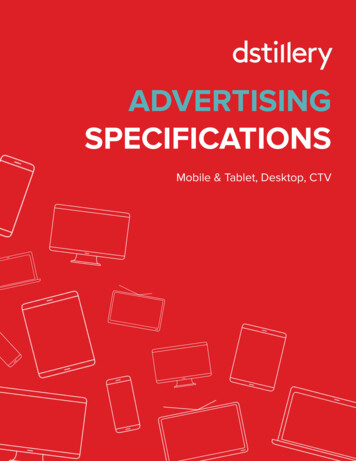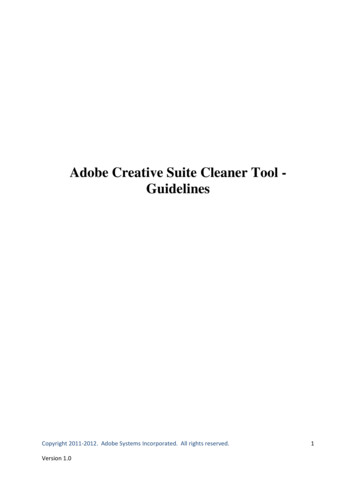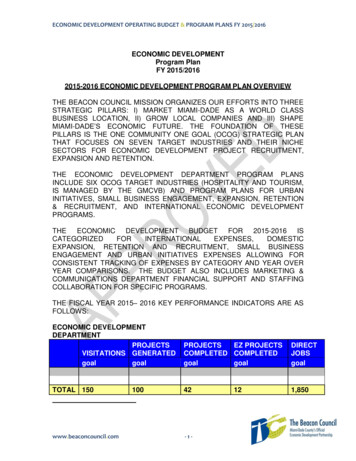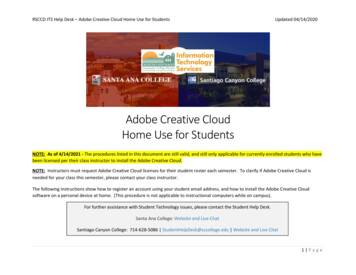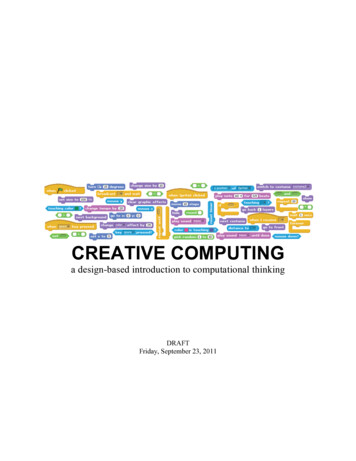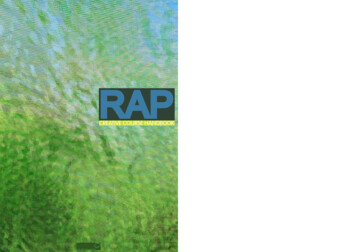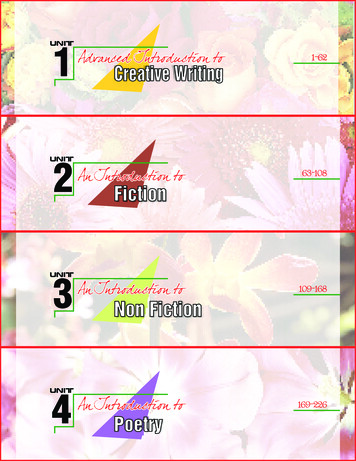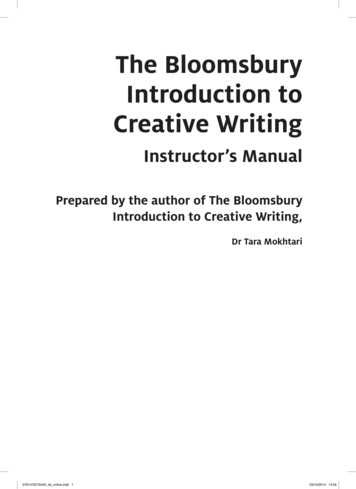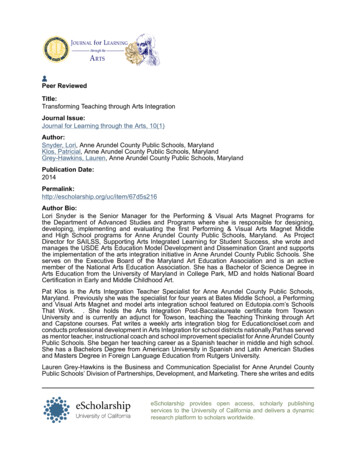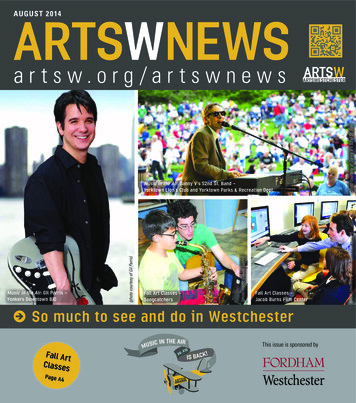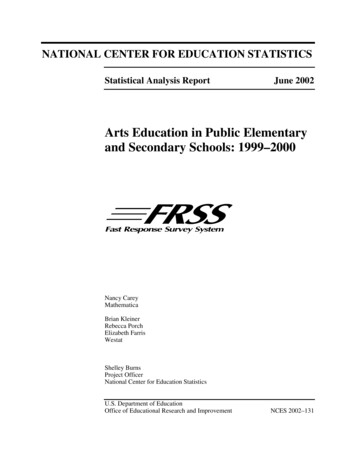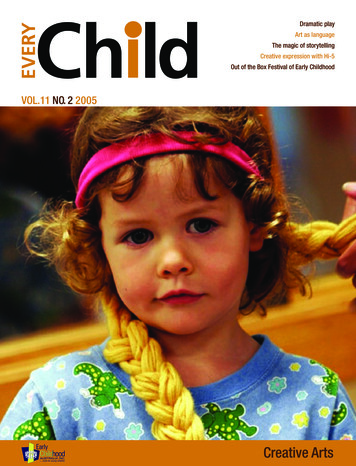
Transcription
Dramatic playArt as languageThe magic of storytellingCreative expression with Hi-5Out of the Box Festival of Early ChildhoodAustralia’s premier national early childhood magazineVOL.11 NO. 2 2005Creative Arts
Special offer!Mega arts pack – for a limited time only.Specially designed for this creative arts issue of Every Child, these six books have been carefully hand picked and arebrimful with ideas, discussion and creative practice. Purchase the books individually or get all six for the discounted priceof 245.50. [ECA Code: ARTPACKMEGA]Learning about ArtKari Winer‘This book offers simple, accessible and practicalideas for encouraging basic creative impulses,and opening pathways for all kinds of curiosity,sensitivity and inventiveness.’ — Shaun Tan, awardwinning children’s author and illustrator of The RedTree and The Lost Thing. 12.95LAH0304Learning about MusicWyverne SmithParents and carers will find this book interesting,enlightening and extremely helpful. It assists inencouraging early childhood music learning throughidentifying and describing supportive learningexperiences which could be provided by anyone,and not just those who have formal music training. 12.95LAH0303Preschool art: It’s the process, not theproductMaryAnn KohlRather than focusing on the finished product ofchildren’s art, this book explores the importanceof the process of art. Preschool art is filled withactivities, suggestions and guidance for helpingchildren to understand the wonders of the processof creation. Suitable for age three to six. 81.95SUND72 245.50Rapunzel’s supermarket: All about youngchildren and their artMega arts packUrsula KolbeRenowned artist and writer Ursula Kolbe depictsyoung children as imaginative thinkers, explorersand artists. The text is accompanied by delightfulchildren’s artworks—expressions of their thoughts,feelings and understandings of the world aroundthem. 72.95SUND46Children, meaning-making and the artsSusan WrightChildren, meaning-making and the arts coversall of the diverse fields within arts education forthe young child. Following in the footsteps of theinfluential work, The arts in early childhood, SusanWright and her new team of expert contributorsprovide a current introduction to theory and practicein arts education in early childhood. 76.95SUND142Storytelling with young childrenJane SmythThrough storytelling, the child’s imaginationis stimulated, their knowledge enhanced andlanguage skills extended. It’s a terrific resource forall educators and carers who wish to develop theirstorytelling capacities and methods, needed toengage young children. 14.95RIP0501Mini 41.95arts packMini arts packThis is Early Childhood Australia’s classic art pack, with all three books encouraging positive art activities for young children.Purchase the following books individually or get all three for the discounted price of 41.95. [ECA Code: ARTPACK]Clay and children: More than makingpotsDrawing and Painting with under threesArt for the child under 7 (seventh edition)Ursula Kolbe and Jane SmythFrances DerhamReprinted due to high demand, this popular bookexplores the endless creative possibilities of clay.Ursula Kolbe explains how clay work can be just ascreative and important for children’s expression asdrawing or painting, and shows how the clay tablecan be made a special place for shared discoveries,social interaction and discussion.Drawing and painting offers very young childrenpowerful ways to explore and communicate theirthoughts and feelings. The authors offer suggestionson how to help children express themselves throughart. Filled with images of children drawing andpainting, the book takes the reader on an illustratedjourney through various levels of children’s artisticdevelopment and expression.First published in 1967 and now in its seventhedition, this is a classic Australian work discussingchildren’s drawing, painting, finger painting, collageand clay modelling. Essentially practical, it is basedon principles that have been thoroughly tested, andwill encourage adults to provide the best settingsand materials for children in any context. The latestedition also has a forward by Barbara Piscitelli. 14.95 14.95 16.95Ursula KolbeRB297RIP0004PUB02See order form on the reverse side of your address label or call 1800 356 900
Contents Editorial2New evidence linking the artsand learning in early childhood Letters to the EditorGuest Statement4How to make kids hatereading. By Jackie French Features6What if . Art as language inearly childhood10Clapping hands and dancingfeet: Exploring creativeexpression with Hi-5 Book Reviews18Out of the Box. QueenslandPerforming Arts Centre’sFestival of Early Childhood18 Regular19And the ‘roo jumped over themoonStorytelling with youngchildrenThe boy who would be ahelicopterThe runaway circus8Kids at the house: Performingarts for children at the SydneyOpera House Profile30Interview with Paula MelvilleClark20Me and my place: How nature,art & play value a child’sunique view of the world14Building drama worlds16When learning becomes simply irresistible26Storytelling abroad241912The power of the story Innovation13Romp, rhyme and revelryYvonne Winer talks about herlatest book, Stories for telling28Building a culture of optimismand persistence with preschoolchildren Health Legal22Anti fast-food messages:Sharing ‘slow food’ withchildren32Excursions, consent and theduty of carewww.earlychildhoodaustralia.org.auCopyright 2005Early Childhood Australia Inc.ISSN 1322-0659 Print Post PP 232100/00035ABN 44 950 767 752Printed by: PirionEditor: Alison ElliottEditorial Board: Pam Linke (Chair),Alison Elliott, Carmel RichardsonMarilyn Fleer and Geraldine Mackey.In-house Editor: Rebecca MestonGraphic Designer: Claire ConnellyPublishing and Marketing Manager: Sue WalesPublishing and Marketing Officer: Dave KingwellMarketing Assistant: Amanda McDonaldCover Photograph: Andrew SikorskiPhotographs: Aussie Shots, G. Elliott-Hall,J. Poynter, Y. Winer, A. SikorskiAdvertising Policy:Editorial Policy:Early Childhood Australia reserves the rightto determine the suitability and quality of anycamera-ready artwork supplied by advertisers. Noadvertisements for products that would be harmfulto families, children and their environments will beaccepted. Claims made in advertisements are theresponsibility of the advertiser.The material published in the magazine will aim tobe inclusive of children in Australia wherever theylive, regardless of race, gender, class, culture, ordisability. The magazine will not publish materialwhich runs counter to the wellbeing and equality ofall children and their families, and those who workwith them. Early Childhood Australia is a registeredcommercial publisher with DEST.Early Childhood Australia Disclaimer:The opinions expressed in this magazine are thoseof the authors and not necessarily those of EarlyChildhood Australia.By publishing a diversity of opinion, we hope toprovide a forum which promotes professionalgrowth, creativity and debate in the early childhoodfield.Address correspondence and advertisingqueries to:The Publishing and Marketing SectionPO Box 7105 Watson ACT 2602Tel: (02) 6242 1800 Fax: (02) 6242 1818Email: publishing@earlychildhood.org.auWebsite: www.earlychildhoodaustralia.org.auAbout Early Childhood Australia:For further information ildhoodaustralia.org.au1
EditorialEarly childhood educators havelong recognised the importanceof creative activities and arepassionate about promoting children’screativity. Most early childhoodcurricula have a strong focus oncreative experiences – especially inmusic, movement and visual arts,because of their acknowledged rolein enhancing children’s intellectual,social and emotional development.to develop literacy and ensure that everychild is a reader. Undoubtedly, this report willhighlight the key role of rich, early languageand literacy experiences for young children.In preschool and child care, the core of theseexperiences is frequently arts-based withchildren’s painting, drawing, singing, dance,and storytelling at the heart of good earlyliteracy programs. Ensuring these traditionalearly childhood activities, complementedby newer digital experiences, translate intoof ‘the arts’. We focus on the critical roleof the visual arts, music, and movementin preschool and child care programs andespecially in developing social and cognitivecompetencies and preparedness for school.Jackie French’s Guest Statement, withthe provocative title How to make kidshate reading, proposes that reading mustbe promoted as fun, worthwhile andimportant ‘secret adult’s business’ if itis to be considered as ‘highly desirable’.Other articles focus on creatingrich dramatic play environments,transforming an early childhoodsetting into ‘a creative sanctuary’and using nature, art and playto draw out and value children’sunique views of the world.New evidencelinking the arts and learning in early childhoodRecently, the longstanding focus oncreative activities has received a resoundingendorsement from neuroscientists workingin the ‘brain research’ area who say thatneural pathways in the brain are formedand shaped by early experiences. In thefirst three to four years in particular, richexperiences are necessary to build thebrain’s neuro-circuitry. This then influencesdevelopment and general wellbeing, andlater academic performance in school.The growing knowledge of how children’sbrains develop has helped refocus andenergise community and governmentinterest in strengthening and expandingearly childhood programs. Current initiatives,such as the Australian Government’sStronger Families, Stronger Communitiesprogram, build on compelling evidence thatearly developmental outcomes are linked tolater wellbeing.In the light of evidence about theimportance of early experience, children’sactive engagement in singing, music andmovement, storytelling, and art and craftactivities, is especially significant. All newand sustained experiences help createunique brain connections that have shortand long term impacts on developmentalpathways.Importantly, as the current National Enquiryinto the Teaching of Literacy draws to aclose, attention is focused on the best ways2Every Childstrong early literacy skills requires thoughtfulplanning and pedagogies that grow out oftargeted initial training and professionaldevelopment.More than at any time in the past, thesocial and economic benefits of integrated,seamless programs of early childhooddevelopment, care and education arebeing discussed and promoted here andinternationally. It is increasingly recognisedthat ‘care’ and ‘education’ cannot beseparated if child development is to beoptimised. Many early childhood educatorswould argue that experiences in the arts areat the core of this integration. They underpinmuch of the developmental programmingwithin services, and draw together the keycomponents of various social and cognitivedimensions of learning.Today, investments in the early years areviewed as sound strategies to achievesocial inclusion and academic success. But,if early childhood services are to meet theneeds of families, communities and childrenthrough the next decade or so, then thevisions, initiatives and strategies must becarefully planned and implemented. Theremust also be renewed rigour in defining andmonitoring outcomes for children.In this issue of Every Child, we continueto inform the debate on strengtheningearly childhood services by looking atdevelopments and issues in the broad areaVolume 11, No. 2, Autumn 2005The range of arts-focused earlychildhood initiatives in centres, schools andthe wider community around Australia isimpressive. But embracing arts activities andunderstanding their value in early childhoodcontexts – especially as a basis for laterlearning – can be the biggest challenge.Ensuring early childhood professionals areable to plan and implement appropriatevisual and performing arts activities foryoung children requires a special focus inearly childhood education training programsand in professional learning programs.Alison ElliottEditor
LettersLetters to the EditorEvery Child readers are invited to respond to articles published in the magazine. Publishing a diversity of opinions(which are not necessarily those of Early Childhood Australia) provides a forum which promotes professionalgrowth, creativity and debate in the early childhood field. By encouraging letters, we would like to build acommunity around Every Child, where readers are involved and engaged. Every Child is for you—so let us knowwhat you think!Please send your letters, marked ‘Every Child’ to either:PO Box 7105 Watson ACT 2602 or by email to: publishing@earlychildhood.org.au.Following the publication of last Every Child, Volume 11 No. 1, wehad these responses:Managing Challenging Behaviour– thumbs up!Please pass on my congratulations to Mimi Wellisch and ViggoKnackstredt for their article Managing challenging behaviour: Isthe environment a factor? in Every Child Volume 11 No. 1 2005.It is wonderful to see a great article on physical environment andfabulous to know that other people are picking up the cause.Prue WalshPlay Environment Consultingwww.playconsulting.comA promise to Australia’s children .Maybe notWhile reading Every Child Volume 11 No. 1, I came across onearticle that I felt needed to be accompanied by some remarks fromthe editor. This was the guest statement [A promise to Australia’schildren] by Parliamentary Secretary for Children and Youth Affairs,Sussan Ley.Ley begins talking about the Government focus on the child, butthen diverges away from the children and begins to focus on howthey [the Government] will be targeting issues like the community.To me, these are issues relating to and certainly affecting the child– but they are not issues that are directly affecting and concerningthe child – such as access to high-quality early childhood servicesthat employ trained staff, and provide positive interactions andopportunities for the children to construct knowledge, leading topositive outcomes for the child.While the provision of high-quality services for children are a soundfinancial investment in the future of a society, this article fails tofocus at all on the benefits for children here and now, and it almostsounds as if children could become part of the Government’seconomical policy with economical benefits rather than havinghuman implications.I became very uncomfortable when I read the next statement: ‘theGovernment believes sound social policy can only be developed anddelivered in partnership with business, community and individuals’.This statement sounds like further support for the Government’sagenda of privatising the child care industry and encouraging privateoperators to solve public problems such as the shortage of birth – twoplaces. Additionally, have we already forgotten that this governmenthad no social policies in the last election, and in fact its commitmentto children was through the welfare sector and supported parentsrather than the services providing the care for children?On the other hand, I felt that the Question and Answer interviewwith Joan Waters was great, especially question seven where shequestions the practice of a few hours ‘“education” surrounded byperiods of “care”’ (p. 5). She recognised that education should notbe confined to one part of the day, but is instead present in all thingswe do.John DorringtonB. Ed (ECE).N.B This is an extract. The letter couldn’t be published in its entirety due tospace constraints.www.earlychildhoodaustralia.org.au3
Guest StatementreadingHow to make kids hateBy award-winning children’sauthor Jackie FrenchHumans are storytellers. It’s the way we passdown our history – ‘official’ written historiesor family memories in conversations onlong car journeys. And books are the bestpossible way of getting lots of stories.Adults read books for fun, excitement,titillation, to relieve stress, conquer boredom,visit new universes, gather ideas. But atthe same time we encourage kids to readbooks, ‘because they are good for them’.Yes, an enthusiastic reader will have a greatvocabulary, have an advantage in everythingfrom writing essays to understanding textbooks and even have a lesser chance ofending up in jail. But none of those are thereasons we read as adults.Books are one of life’s great adventures.So why don’t some kids read?1. The wrong booksSo often I meet despairing parents who adorereading – but despite all the books they’vetempted their kids with, their children stillaren’t avid readers. Temperament oftenskips a generation. The very books you lovedare the ones your kids may find boring.(They may have a lot more in common withtheir grandparents.) And the more kids areurged to read books they find boring, themore they are convinced that reading as anactivity is boring too.Many boys – and a few girls too – just don’tlike fiction. (I’m married to a man like that!4Every ChildThey do like reading – but they want it to beabout real things. They like stories too, butthey need to be real stories, like historiesand biographies.)Sometimes, with the best intent in theworld, ‘non-fiction’ kids are coaxed toread funny, light stories – and find themtotally unsatisfying. Often, again with thebest intentions, kids are given short, funnybooks. This is the type of book a reluctantreader will choose if they’re told they haveto read a book – the shorter the better. Buta more challenging book may be the onethat will really show the child how satisfyingbooks can be.You know you’ve found the right book for achild when they clutch it to them and refuseto stop reading to eat dinner and want acopy of their very own, even if their olderbrother owns one already.Let kids choose their own books, at thelibrary and the bookshop! Time after timewhen I’m signing books at a bookshop, I seeparents urge kids to read the book they’resure their child will love – and miss thesignals when the child is really fascinatedby something their parent would finduninteresting.Books aren’t like broccoli – you don’t haveto finish it because it’s good for you. Nevermake kids finish a book! (We don’t asadults, so why should they?) Kids can beintimidated by a new kind of book or longerVolume 11, No. 2, Autumn 2005books or books without illustrations if theyfeel they have to read it all. Let kids read sixbooks at once: a long book, a funny book, abook for the bathroom and a book for theirbed . so they can read exactly what theyfeel like reading!Kids need to be taught how to find books.Even adults find it hard to find the booksthey like! Teach kids about bookshops,libraries, swapping books with mates,second-hand bookshops. Teach kids howto ‘taste’ a book, reading a bit here andthere to see if it’s one they’d like. Too muchpressure to do it properly only turns themoff the whole idea.2. Learning difficultiesI’m dyslexic – a useful catchphrase that justmeans I have problems reading the waymost people do. With my form of dyslexiait’s torture to try to read a few big wordson a page or, even worse, follow the lineof text with my finger. With the very bestof intentions, so often kids with my form ofdyslexia are given reading texts with lots ofwhite space, bright pictures and large text. and all this teaches them is that they arevery, very dumb, not to be able to read evenbaby words.There are far too many reasons why kids mayhave problems learning to read to go intohere (see Rocket your child into reading).But please, please, please, speaking as a
dyslexic reader and as a parent and auntof dyslexic kids too, kids who have readingdifficulties need different teaching methodsfrom kids who are just slow learners.You need to know why a kid has problemsto work out the best way to help them.There is no one size fits all, portmanteausolution for reading problems – they are asindividual as the children who are affectedby them. Does this child need a speechpathologist? An occupational therapist tohelp them learn to concentrate? A specialistophthalmologist who’ll give them exercisesto improve tracking and coordination? Andthis is just the start!Kids also learn in different ways. Some kidsare ‘kinetic learners’ – usually active boysbut also many girls who literally processinformation better if they’re physicallymoving around. Kids don’t have to sit stillto learn to read! Give them a water pistolso they can make their letters on the pavingoutside, or in the sandpit.Often girls are ‘social learners’ – things areonly real to them when they share it withtheir friends! So sit them at the table withtheir stuffed animals, so lessons are shared –then they can teach the dog to read as well.‘Books aren’t like broccoli– you don’t have to finish itbecause it’s good for you.’3. TelevisionKids need to learn many things to learn toread: how to track, concentrate, coordinate,know how words are pronounced . andthe trouble is, kids who watch a lot of TVdon’t learn any of these!Do you remember the game we used to playas kids? You throw the ball at a wall withone hand, then the other hand, then underone leg . and no one ever said, ‘Hey, kids,this is a great tracking and coordinationexercise’. It was just fun!The games kids play in every society arethe ones they need to learn adult skills.But when kids watch TV they just sit there!When the TV is on all the time, too, kidsaren’t learning how words are pronounced– it’s hard to concentrate with a blur ofvoices around you all the time.though that is not what they would expressif they were asked.Books are the best way to journey into asmany universes as possible. They’re fun,they’re mind stretching, they’re a refuge.A life without books is like a life withoutchocolate, multiplied a million times. Weneed to teach kids that reading is highlydesirable, secret adult’s business, the key toa universe of books.Jackie FrenchJackie is the author of over 100 books forchildren and adults, with over 40 literaryand children’s choice awards in Australia andoverseas. Her book Rocket your child intoreading (Harper Collins) is about how to help allchildren to read and love books.Encourage kids to do things while theywatch TV! Dangle a foam ball from thelight fitting and encourage them to hit itwith each hand, then kick it with each foot.Give them blocks, Lego, encourage themto dance, sew, knit, draw. The earlier theylearn that TV viewing time is a time to dothings, not just sit and absorb, the better!You might also find that the kids are lesstetchy once they are actively engaged ratherthan in that strange, zoned-out state ofpassivity that is conventional TV viewing.Often their behaviour (querulous, restless,irritable) indicates that they are bored, evenRocket your child into reading, published by HarperCollins, is available for 19.95 from all good bookstoresThe Children’s Book of the Year awardsThe Children’s Book Council of Australia recently announced its shortlist for the 2005 Book of the Year awards.Books beneath the category of ‘Early childhood’ are as follows:2005 Book of the Year: Early childhoodDray, MattDougal the garbage dump bearViking, Penguin Books Australia, 2004Farrer, VashtiMr Noah and the cats(Start-Ups) Lothian Books, 2004Where is the green sheep?Viking, Penguin Books Australia, 2004Graham, BobTales from the waterholeWalker Books, 2004King, Stephen MichaelMutt dog!Scholastic Press, Scholastic Australia, 2004Wild, MargaretSeven more sleepsWorking Title Press, 2004Illus. Neil CurtisFox, MemIllus. Judy HoracekIllus. Donna RawlinsFor more information on the Children’s Book Council, visit: www.cbc.org.au.www.earlychildhoodaustralia.org.au5
FeatureWhat if.?ARTas language inearly childhood‘Is art really important?’‘What is art?’Questions like these are usually better arguedin my house over a couple of bottles of wineand a good dinner party. But of course,there are no easy answers. Neverthelesswe expect to see, in any early childhoodsetting or classroom, samples of children’scolourful paintings, drawings and visualrepresentations. But why do we do art withyoung children . and how do we read it?There is any number of ways of seeing art: itgives schools and settings a ‘look’. We read itas evidence of busy, happy, healthy children.It is other to ‘work’. It is a tradition in earlychildhood settings, the origins of which areperhaps lost on us. It is a means of ‘selfexpression’, ‘creativity’. It is ‘therapeutic’. Ithelps develop fine motor skills (this, as a mainreason, can set my teeth on edge!). Each ofthese views of art carry some truths, and canshape the decisions we make about how,when and why we teach art.I have many conversations with both preservice and in-service teachers about theimportance of ‘creativity’, ‘self-expression’and ‘art’, and we nod our heads and agree– sometimes while we are looking togetherat 25 paper plates displayed on the wall,decorated fairly identically to resemble, say, astylised version of a lion. Paul Duncum (2001)refers to this as ‘bunny-bum’ art, and in thisarticle, I attempt to explore some of theseways of seeing art, and in so doing, raisesome new questions.6Every ChildWhat if there was no such thing as art?Can you imagine a world without art? We would have very little ancient history, no cavepaintings, Egyptian hieroglyphics, records of ancient people’s religious beliefs, customsor culture. No weavings, pottery. No music – no blues, jazz, hula, Beethoven, Mozart,nursery rhymes, Rolling Stones, Beatles, Elvis, Powderfinger, Wiggles. No Michelangelo,Salvador Dali, Albert Namatjirra, Frida Kahlo. No cathedrals, galleries. No Stonehenge,pyramids, temples, Eiffel Tower. No movies – no Sound of Music, Priscilla Queen of theDesert, Mad Max, Finding Nemo. No novels – no Pride and Prejudice, Da Vinci Code,Catcher in the Rye, To Kill a Mockingbird. No poets, dancers, actors, designers. No Kathand Kim . I can’t go on! This would mean we were condemned to evenings of BigBrother and Burke’s Backyard . or watching the grass grow.Our knowledge of the world, and our existence as human beings would be vastlydifferent without art. It is art that sets us apart from other living things, and it is artwhich can lift us to a higher plane, sometimes helping us to see, feel and express whatwords cannot say.When art is all this and more, I can’t help but think it is sold short when we justify‘bunny-bum’ art and colouring in with the argument that it assists with the developmentof fine motor skills. I think you would agree that those who created the cave paintings,the Mona Lisa, the hieroglyphics, were on about more than developing their fine motorskills. They wanted us to see things. They were engaged in creative acts which speakto us across time and place.Volume 11, No. 2, Autumn 2005
What if there was a languagethat everyone in the worldspoke?There is . it’s art. I am not referring to thelanguage of art catalogues:‘It became a cliché in the work of followers likePalma il Giovane, but here it has all the force ofa novel idea’.‘ . is regarded by Professor Michael Jaffé ofthe Fitzwilliam Museum, Cambridge, as amasterpiece and a splendid example of VanDyck’s Genoese portraiture’.I mean a language that you can know withyour mind, heart, body, and ‘soul’, if you like.I feel it when I walk into a cathedral, when Ilook at a sunset, and when I look at one ofNolan’s paintings of the vast, empty interiorlandscape of Australia. It can bring a lump tomy throat when I watch a sad play or movie,and I empathise with the actors. I can feel athrill when I watch the New Zealand haka, orAfrican tribespeople, in full regalia, singing anddancing their tribal music. Gospel choirs canlift me, and reggae music can make me wantto party. Art can help us to laugh and cry – atweddings, funerals, and other big events in ourlives. The national anthem can move me, and socan Waltzing Matilda. For that matter, the flagsof countries can say so much, through simplecombinations of colours, shapes and lines. TheUnion Jack, in the corner of the Australian flag,tells a story of our history and colonisation.help. If artistic development and mastery is, indeed, a natural occurrence, why then arewe not all fantastic artists?How do artists learn to paint, draw, sculpt? They are taught. Many of the earlier artistsstudied from their masters for years. Currently, most artists have been trained in art forat least as long as we all have to become educators.Where does this ‘hands off’ approach come from? The taboos against ‘teaching’,particularly in early childhood education, are persistent when it comes to art (McArdle,2001). One of the most pervasive of these beliefs is that correcting children’s artwork,or saying anything less than praise, will damage the child’s self-esteem. But what buildsself-esteem? A sense of confidence, accomplishment and mastery.Let’s think about how we teach children to read and write the English language. Wecall on a vast repertoire of strategies. We demonstrate; we have conversations; weprovide opportunities for frequent practice; we correct; we drill; we teach skills andtechniques; we question; we expose children to models of exemplary language; weimmerse them in the language. Imagine if we were teaching children to learn to readand we announced that, since they had been working with letters and words for afew weeks, we were going to change things for this week. We don’t want them to bebored so we will introduce a new ‘gimmick’, and for this week, they will not work withletters and words, but instead, will work with a piano and a basketball. And yet, insteadof teaching children the skills and techniques for successful use of the basic tools forartistic communication—brushes and pencils—we urge them to communicate withfeathers, balloons and marbles. Such gimmicks produce random results, not deliberatecommunication.ConclusionI hope my questions have started you thinking about your approach to art education,and I will finish with a couple more ‘what ifs’:What
Art as language The magic of storytelling Creative expression with Hi-5 Out of the Box Festival of Early Childhood Creative Arts. 245.50 Mega arts pack Learning about Art Kari Winer ‘This book offers simple, accessible and practical ideas
